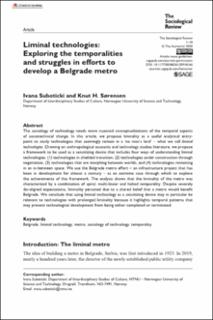| dc.contributor.author | Suboticki, Ivana | |
| dc.contributor.author | Sørensen, Knut Holtan | |
| dc.date.accessioned | 2020-05-15T08:10:33Z | |
| dc.date.available | 2020-05-15T08:10:33Z | |
| dc.date.created | 2020-05-06T13:31:17Z | |
| dc.date.issued | 2020 | |
| dc.identifier.issn | 0038-0261 | |
| dc.identifier.uri | https://hdl.handle.net/11250/2654572 | |
| dc.description.abstract | The sociology of technology needs more nuanced conceptualizations of the temporal aspects of sociotechnical change. In this article, we propose liminality as a useful analytical entry-point to study technologies that seemingly remain in a ‘no man’s land’ – what we call liminal technologies. Drawing on anthropological accounts and technology studies literature, we propose a framework to be used as a sensitizing device that includes four ways of understanding liminal technologies: (1) technologies in shielded transition, (2) technologies under construction through negotiation, (3) technologies that are morphing between worlds, and (4) technologies remaining in an in-between space. We use the Belgrade metro effort – an infrastructure project that has been in development for almost a century – as an extreme case through which to explore the achievements of this framework. The analysis shows that the liminality of the metro was characterized by a combination of spiral, multi-linear and halted temporality. Despite severely dis-aligned expectations, liminality persisted due to a shared belief that a metro would benefit Belgrade. We conclude that using liminal technology as a sensitizing device may in particular be relevant to technologies with prolonged liminality because it highlights temporal patterns that may prevent technological development from being either completed or terminated. | en_US |
| dc.language.iso | eng | en_US |
| dc.publisher | SAGE Publications | en_US |
| dc.rights | Navngivelse 4.0 Internasjonal | * |
| dc.rights.uri | http://creativecommons.org/licenses/by/4.0/deed.no | * |
| dc.title | Liminal technologies: Exploring the temporalities and struggles in efforts to develop a Belgrade metro | en_US |
| dc.type | Peer reviewed | en_US |
| dc.type | Journal article | en_US |
| dc.description.version | publishedVersion | en_US |
| dc.source.journal | Sociological Review | en_US |
| dc.identifier.doi | https://doi.org/10.1177%2F0038026120918166 | |
| dc.identifier.cristin | 1809667 | |
| dc.description.localcode | This article is distributed under the terms of the Creative Commons Attribution 4.0 License (http://creativecommons.org/licenses/by/4.0/) which permits any use, reproduction and distribution of the work without further permission provided the original work is attributed as specified on the SAGE and Open Access page (https://us.sagepub.com/en-us/nam/open-access-at-sage). | en_US |
| cristin.ispublished | true | |
| cristin.fulltext | original | |
| cristin.qualitycode | 2 | |

